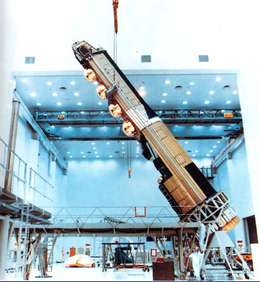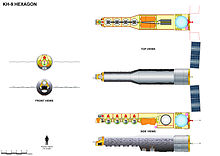 A KH-9 HEXAGON during assembly by Lockheed | |||||||||||
| Mission type | Imagery intelligence | ||||||||||
|---|---|---|---|---|---|---|---|---|---|---|---|
| Operator | National Reconnaissance Office | ||||||||||
| Spacecraft properties | |||||||||||
| Manufacturer |
| ||||||||||
| Launch mass | 11400 kg to 13300 kg (with mapping camera) | ||||||||||
| Dimensions | 16.2 m × 3.05 m (53.1 ft × 10.0 ft) | ||||||||||
| Start of mission | |||||||||||
| Rocket | Titan III | ||||||||||
| Launch site | Vandenberg Air Force Base, SLC-4E | ||||||||||
| Contractor | Martin Marietta | ||||||||||
| Orbital parameters | |||||||||||
| Reference system | Sun-synchronous orbit | ||||||||||
| Regime | Low Earth orbit | ||||||||||
| Perigee altitude | 170 km (110 mi) | ||||||||||
| Apogee altitude | 260 km (160 mi) | ||||||||||
| Inclination | 97° | ||||||||||
| Main telescope | |||||||||||
| Type | folded Wright camera | ||||||||||
| Diameter | 0.91 m (3 ft 0 in) | ||||||||||
| Focal length | 1.52 m (5 ft 0 in) | ||||||||||
| Focal ratio | f/3.0 | ||||||||||
| Wavelengths | visible light, Near-infrared | ||||||||||
| |||||||||||

KH-9 (BYEMAN codename HEXAGON), commonly known as Big Bird or KeyHole-9,[1] was a series of photographic reconnaissance satellites launched by the United States between 1971 and 1986. Of twenty launch attempts by the National Reconnaissance Office (NRO), all but one were successful.[2] Photographic film aboard the KH-9 was stored on RCA Astro Electronic Division take up reel system then sent back to Earth in recoverable film return capsules for processing and interpretation. The highest ground resolution achieved by the main cameras of the satellite was 2 ft (0.61 m),[3] though another source says "images in the "better-than-one-foot" category" for the last "Gambit" missions.[4]
They are also officially known as the Broad Coverage Photo Reconnaissance satellites (Code 467), built by Lockheed Corporation for the NRO.[1]
The satellites were an important factor in determining Soviet military capabilities and in the acquisition of accurate intelligence for the formulation of U.S. national policy decisions as well as deployment of U.S. forces and weapon systems. The satellites were instrumental in U.S. National Technical Means of Verification of Strategic Arms Limitation Talks (SALT) and the Anti-Ballistic Missile Treaty (ABMT).[5]
The KH-9 was declassified in September 2011 and an example was put on public display for a single day on 17 September 2011 in the parking lot of the Steven F. Udvar-Hazy Center of the National Air and Space Museum.[6][7][8]
On 26 January 2012, the National Museum of the United States Air Force put a KH-9 on public display along with its predecessors the KH-7 and KH-8.[9]
- ^ a b Yenne, Bill (1985). The Encyclopedia of US Spacecraft. Exeter Books (A Bison Book), New York. ISBN 0-671-07580-2. p.32 Big Bird
- ^ "34D-9: Titan rocket with last KH-9 explodes after liftoff (18 April 1986) (F)". 16 December 2012. Archived from the original on 21 December 2021 – via YouTube.
- ^ Cite error: The named reference
NRO_US_Securitywas invoked but never defined (see the help page). - ^ Deutsch, Ricky (12 November 2020). "Controlling Hexagon". Retrieved 19 April 2022.
- ^ "Assessment of Intelligence Gain Provided by KH-9 over KH-4 and KH-8" (PDF). NRO. Retrieved 7 January 2023.
 This article incorporates text from this source, which is in the public domain.
This article incorporates text from this source, which is in the public domain.
- ^ "NRO Observes 50th Anniversary with Declassification".
- ^ "Declassified US Spy Satellites Reveal Rare Look at Secret Cold War Space Program". Space.com. 18 September 2011.
- ^ Doyle, John M., Big Bird, uncaged, Air and Space, December 2011/January 2012, p.10
- ^ Cohen, Aubrey, "Three former spy satellites go on display" Seattle Post-Intelligencer 26 January 2012